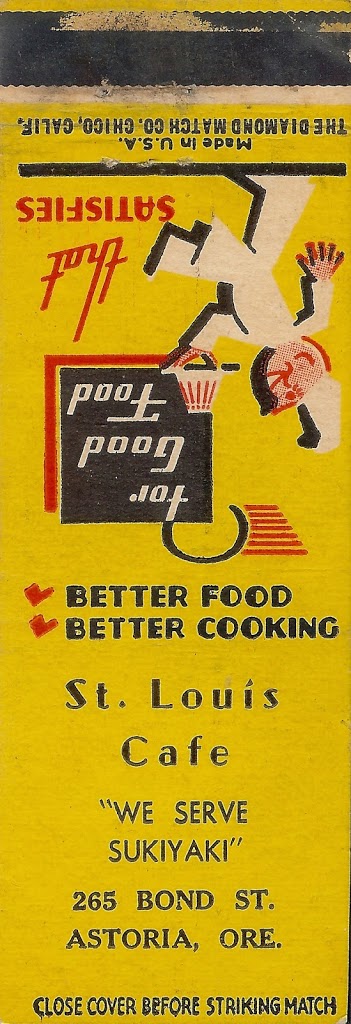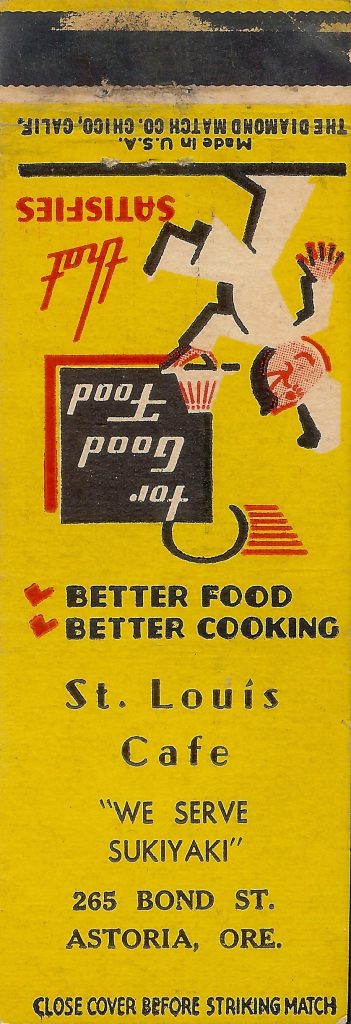Astoria: Sukiyaki and St. Louis

 Paper ephemera—items like restaurant menus, product brochures, and recipe booklets—have been the triggers for much of my research into Oregon’s food history. Matchbooks are pretty small, with little room to suggest a story. I’ve never collected them.
Paper ephemera—items like restaurant menus, product brochures, and recipe booklets—have been the triggers for much of my research into Oregon’s food history. Matchbooks are pretty small, with little room to suggest a story. I’ve never collected them.
Well, until recently. Here’s a story from one little matchbook.
Astoria is one of Oregon’s most cosmopolitan small towns. It’s a seaport and a fishing and lumbering center with a large population of Scandinavian (Swedish, Norwegian, Danish) immigrants along with many others (Finnish, Greek, Croatian) added to the usual Oregonians (Missourian, German, Iowan, British, Minnesotan, etc.). There were many Chinese working in the fish canneries, and some Sikhs in the lumber mill. More variety than one expects in Oregon.
As this matchbook told me, there were Japanese in Astoria, too, and there was a Japanese restaurant called the St. Louis—I have no idea what inspired the name. The 1931 Polk city directory shows the St. Louis Café at 276 Bond Street, on the north side of the street between 6th and 7th Streets. (Astoria house numbers have since changed.), It was operated by Takio Kobayashi, who then lived on 7th Street between Bond and Astor. This is in the midst of what was Astoria’s two-block Chinatown. The 1936, 1938, and 1940 city directories list the St. Louis Café on the south side of Bond Street at 265, as it shows on the matchbook. The directories also show Takio, and his wife Chitose, as living at the same address.
Were there other Japanese in Astoria in the 1930s? Did they also live in its Chinatown? Did any return after World War II? Oregon had Japanese American communities in Portland, eastern Multnomah County, Treasure Valley, and the Hood River Valley, but Takio and Chitose were outliers in Astoria. As evidenced by the matchbook, their restaurant probably catered to a non-Japanese clientele, but presumably one that knew what sukiyaki was, and that it was worth seeking out. Here’s an unexplored Astoria history niche.
Afterword: The 1930 and 1940 census list Takio Kobayashi. In 1930, Clatsop County had about 276 Japanese residents, 62 of them in Astoria. The remainder were shown in precincts that suggest they were working in lumber camps and mill towns: Westport, Wauna, Camp McGregor, Vesper, and Mishawaka (near Elsie), with a few scattered in John Day, Hammond, and Clifton. In 1940, Takio Kobayashi, born ca. 1889, age 51, is shown along with his wife Chito, age 40, and their children Marcia (13), George (10), and Ken (4).
John Goodenberger, Astoria historic preservationist and historian, shared with me the story of another member of Astoria’s Japanese community, Tomaso Hayashi. Hayashi graduated from Astoria High School in 1933, was a champion swimmer, graduated from the University of Oregon, and returned to his home town to work for the Columbia River Packers Association (CRPA). In 1942 he along with other Japanese in Astoria was sent to an internment camp–Hayashi never returned to Astoria.You can hear his account in the Immigrant Gallery at the Clatsop County Historical Society museum.
2 Responses
just looked at the 1940 Japanese-American Citizens League "Directory" for "Portland and Vicinity; Snake River Valley; Boise Valley." For Astoria:
Morikawa, Shizego, St. Mary Hospital
Sumida, James (Yoshio), Route 2, Box 140
Shizuyo, Ben, Paul, Alex [same address as Sumida]
Wrong date above…meant to write 1948
Comments are closed.